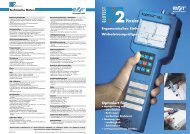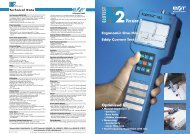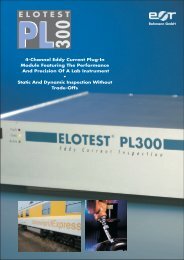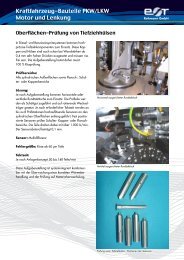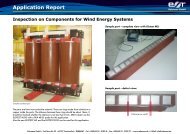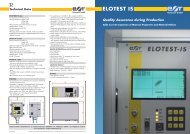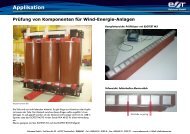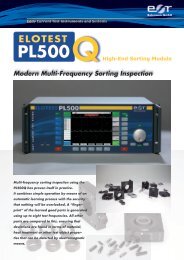You also want an ePaper? Increase the reach of your titles
YUMPU automatically turns print PDFs into web optimized ePapers that Google loves.
Eddy Current Instruments and Systems<br />
Digital eddy current testing<br />
for the metal processing industry<br />
<strong>ELOTEST</strong> <strong>IS500</strong><br />
• With high-resolution color display<br />
• For crack detection and/or material sorting<br />
• Can be integrated directly into the production line<br />
Rohmann GmbH<br />
NEW
<strong>ELOTEST</strong><br />
<strong>IS500</strong><br />
Technical Data<br />
General<br />
The focus of the new instrument family is the fully digitized signal processing<br />
chain on the NF-side (after demodulation) with a bandwidth of 10<br />
kHz and ultrafast multiplexing capability featuring a multiplexing rate of<br />
32 kHz (probe to probe).<br />
The full dynamics of 96 dB (digital) across the frequency range from<br />
10 Hz to 12 MHz speak for themselves.<br />
The display is something special, too:<br />
The display of an analog tube is simulated in a digital manner with adjustable<br />
persistence and so far unmatched definition and brilliance– simply<br />
the best analog display, if it wasn’t digital and thus a effective combination<br />
of traditionally proven and modern technology.<br />
Technical data<br />
Screen display<br />
• Color TFT display, 800 x 480 pixel (WVGA), 229 mm (9”) diagonally,<br />
16:9 format<br />
• Simultaneous display of up to 8 signals with a display rate of<br />
250,000 signal dots per second for each channel (in real time)<br />
Test Channel Module<br />
Frequency range<br />
• 10 Hz - 12 MHz<br />
• Driver output: +/-10Vs; max. 300mA<br />
Bandwidth useful signal<br />
• 10 kHz<br />
• Fully digitized signal processing; featuring a digitizing rate of<br />
250 kHz with a resolution of 2 x 16 bit<br />
Pre-amplification<br />
• -16.5 – 60 dB adjustable in 0.5 dB-increments<br />
Gain<br />
• -0 – 80 dB adjustable in 0.5 db-increments<br />
• Additional 0 – 20 dB axis spread for the X- and/or the Y-axis<br />
Signal filter<br />
• HP/LP independently adjustable from 1 Hz to 10 kHz in<br />
20 logarithmic steps per decade => a total of 80 filter steps<br />
Phasing<br />
• 0 - 359° in 0.5°-increments<br />
Real time gates for evaluation<br />
• 2 gates per channel; selectable mode X, Y, Box, circle, flattened<br />
circle<br />
Connection standard probes to the test channel module<br />
• 26-pin HD-Sub-connector to connect all probe types<br />
(Note: no rotor power supply for hand-held rotors)<br />
Input/output connector<br />
• 24 In<br />
• 16 Out<br />
• 24 V opto entkoppelt<br />
• 2 Zählereingänge<br />
Analog output<br />
• Max. ±10V amplitude<br />
Distance compensation option<br />
• A test channel module can optionally be equipped with a multiplexed<br />
distance compensation. This enables automatic amplification compensation<br />
during tests that do not have a consistent distance between the test<br />
pieces. The control rage is ± 30 dB.<br />
General information on the instrument:<br />
Housing data:<br />
Housing<br />
IP30 protective system<br />
Dimensions<br />
Width: 470 mm (185“)<br />
Depth: 273 mm (107“)<br />
Height:296 mm (116,5“)<br />
Weight<br />
16 kg (35,3 lb)<br />
Rohmann GmbH<br />
Rohmann GmbH • Carl-Benz-Str. 23 • 67227 Frankenthal • GERMANY • Tel. +49(0)62 33 - 3789-0 • Fax +49(0)62 33 - 3789-77<br />
www.rohmann.de • E-Mail: info@rohmann.de<br />
Option: Multiplex operation<br />
Two (2) types of multiplex operation are possible:<br />
1. Parameter multiplex (“frequency multiplex”)<br />
In the test channel various parameters such as frequency, gain, phase,<br />
filter etc. may be set successively for one and the same probe during<br />
probe multiplex operation. Depending on the selected test frequency, the<br />
change-over frequency may be up to 32 kHz. The parameter-multiplex<br />
operation is a standard feature of the test instrument.<br />
2. Probe multiplex<br />
During probe-multiplex operation one and the same channel may be<br />
switched to several probes in rapid succession. Depending on the selected<br />
test frequency, the change-over frequency may also be up to<br />
32 kHz.<br />
For the probe-multiplex operation at least one (1) probe-multiplex module<br />
(optional) will be required.<br />
Probe-multiplex module:<br />
Available as external multiplexer box:<br />
• Basic configuration: 8 each symmetrical (or earth-related) transmitter<br />
outputs and receiver inputs; may be upgraded for up to 32 transmitter<br />
outputs and receiver inputs<br />
• External module in IP65 with 8 separate 26-pin HD-SUB IP65<br />
connectors, max. distance to test channel = 30 m (customer-specific<br />
external multiplexer module available upon request)<br />
Q500 sorting channel module<br />
Channel module for the automatic self-learning structural and sorting<br />
inspection using up to 8 channels.<br />
• 8 time-multiplexed test frequencies from 10 Hz to 150 kHz<br />
• Fully digitized full-wave demodulator for the highest precision and<br />
stability<br />
• Determination of the inspection point in 1.5 waves trains per frequency<br />
• Self-learning “BubbleGate” evaluation gates<br />
• Guided learning from goods parts<br />
• Sorting of up to 8 good batches („MultiLot“)<br />
• Retroactive teaching of good batches („RetroTeach“)<br />
• Integrated interface and programmable driver logic for sorting switches<br />
and systems<br />
XY display during crack detection<br />
Sorting mode “BubbleGate” in the new PL500-module<br />
Doc. <strong>IS500</strong>/04_11 All rights reserved. Patent pending. Protection of registered design MR 1.140. As part of the continued development we reserve the right to make technical modifications without prior announcement.




